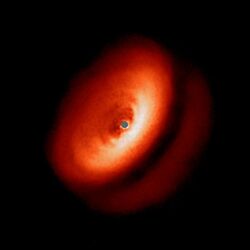IM Lupi
Topic: Astronomy
 From HandWiki - Reading time: 3 min
From HandWiki - Reading time: 3 min
| Observation data Equinox J2000.0]] (ICRS) | |
|---|---|
| Constellation | Lupus |
| Right ascension | 15h 56m 09.2067s[1] |
| Declination | −37° 56′ 06.1261″[1] |
| Apparent magnitude (V) | 11.93 |
| Characteristics | |
| Evolutionary stage | Young Stellar Object |
| Spectral type | M0[2] |
| Variable type | Orion variable of T Tauri type (INT)[3] |
| Astrometry | |
| Proper motion (μ) | RA: -12.059[1] mas/yr Dec.: -23.727[1] mas/yr |
| Parallax (π) | 6.4175 ± 0.022[1] mas |
| Distance | 508 ± 2 ly (155.8 ± 0.5 pc) |
| Details[4] | |
| Mass | 1 M☉ |
| Luminosity | 0.9 L☉ |
| Age | 0.5 - 1 Myr |
| Other designations | |
| Database references | |
| SIMBAD | data |
IM Lupi is a young stellar object with a surrounding protoplanetary disk. The young star is suspected to host a still forming protoplanet at a distance of 110 astronomical units (AU) and a mass of 2-3 |♃|J}}}}}}.[5][6] IM Lupi is 508 light-years (156 parsec) distant.[6]
Star
The star IM Lupi was classified as a class II YSO with a spectral type M0.[2] The star is probably not actively accreting, but there is evidence that the accretion is variable around IM Lupi. The young star is associated with the Lupus 2 Molecular Cloud.[4]
Protoplanetary Disk
Many features at different wavelengths have been observed in this disk, which is very massive (0.17 M☉).[5][4] The disk has a gas and a dust component. The gas component reaches out to 751 AU and the smaller dust component reaches out to 334 AU. In a scattered light image from SPHERE the upper surface and part of the lower surface was imaged.[7] Dust observations with ALMA shows two rings and with SPHERE 2 additional rings were detected.[4][7] ALMA observations at 1.25 mm shows a spiral pattern,[8] which is also imprinted on the surface of the dusty part as seen by SPHERE.[5] ALMA also observed the molecule 12CO, which traces the gas component of the disk. The CO observations show several deviations from Keplerian motion in the form of 16 kinks. The kinks and spirals could be caused by an undetected planet with a mass of 2-3 MJ orbiting at about 110 AU. It is also possible that gravitational instability causes the patterns in this disk.[6]
References
- ↑ 1.0 1.1 1.2 1.3 1.4 Gaia Collaboration (2020-11-01). "VizieR Online Data Catalog: Gaia EDR3 (Gaia Collaboration, 2020)". VizieR Online Data Catalog: I/350. Bibcode: 2020yCat.1350....0G. https://ui.adsabs.harvard.edu/abs/2020yCat.1350....0G.
- ↑ 2.0 2.1 Salyk, Colette; Herczeg, Gregory J.; Brown, Joanna M.; Blake, Geoffrey A.; Pontoppidan, Klaus M.; van Dishoeck, Ewine F. (2013-05-01). "Measuring Protoplanetary Disk Accretion with H I Pfund β". The Astrophysical Journal 769 (1): 21. doi:10.1088/0004-637X/769/1/21. ISSN 0004-637X. Bibcode: 2013ApJ...769...21S. https://ui.adsabs.harvard.edu/abs/2013ApJ...769...21S.
- ↑ Watson, C. L.; Henden, A. A.; Price, A. (2006-05-01). "The International Variable Star Index (VSX)". Society for Astronomical Sciences Annual Symposium 25: 47. Bibcode: 2006SASS...25...47W. https://ui.adsabs.harvard.edu/abs/2006SASS...25...47W.
- ↑ 4.0 4.1 4.2 4.3 Cleeves, L. Ilsedore; Öberg, Karin I.; Wilner, David J.; Huang, Jane; Loomis, Ryan A.; Andrews, Sean M.; Czekala, Ian (2016-12-01). "The Coupled Physical Structure of Gas and Dust in the IM Lup Protoplanetary Disk". The Astrophysical Journal 832 (2): 110. doi:10.3847/0004-637X/832/2/110. ISSN 0004-637X. Bibcode: 2016ApJ...832..110C.
- ↑ 5.0 5.1 5.2 Hensley, Kerry (2022-08-01). "Evidence for a Hidden Planet in IM Lupi's Disk" (in en-US). https://aasnova.org/2022/08/01/evidence-for-a-hidden-planet-in-im-lupis-disk/.
- ↑ 6.0 6.1 6.2 Verrios, Harrison J.; Price, Daniel J.; Pinte, Christophe; Hilder, Thomas; Calcino, Josh (2022-07-01). "Kinematic Evidence for an Embedded Planet in the IM Lupi Disk". The Astrophysical Journal 934 (1): L11. doi:10.3847/2041-8213/ac7f44. ISSN 0004-637X. Bibcode: 2022ApJ...934L..11V.
- ↑ 7.0 7.1 Avenhaus, Henning; Quanz, Sascha P.; Garufi, Antonio; Perez, Sebastian; Casassus, Simon; Pinte, Christophe; Bertrang, Gesa H. -M.; Caceres, Claudio et al. (2018-08-01). "Disks around T Tauri Stars with SPHERE (DARTTS-S). I. SPHERE/IRDIS Polarimetric Imaging of Eight Prominent T Tauri Disks". The Astrophysical Journal 863 (1): 44. doi:10.3847/1538-4357/aab846. ISSN 0004-637X. Bibcode: 2018ApJ...863...44A.
- ↑ Andrews, Sean M.; Huang, Jane; Pérez, Laura M.; Isella, Andrea; Dullemond, Cornelis P.; Kurtovic, Nicolás T.; Guzmán, Viviana V.; Carpenter, John M. et al. (2018-12-01). "The Disk Substructures at High Angular Resolution Project (DSHARP). I. Motivation, Sample, Calibration, and Overview". The Astrophysical Journal 869 (2): L41. doi:10.3847/2041-8213/aaf741. ISSN 0004-637X. Bibcode: 2018ApJ...869L..41A.
 |
 KSF
KSF
